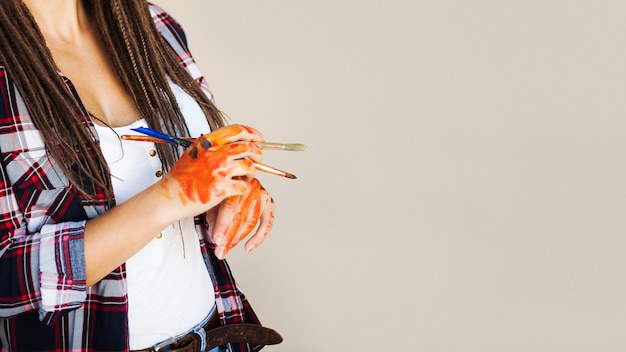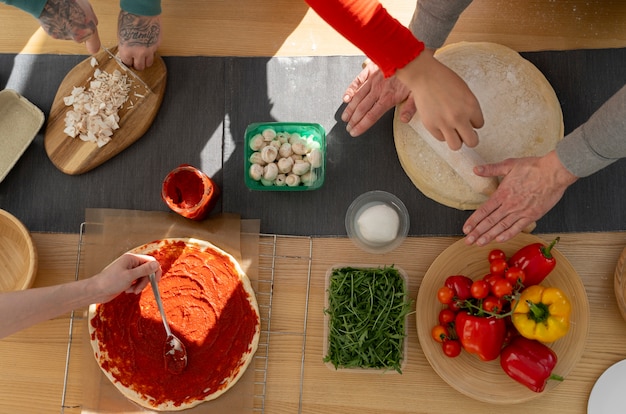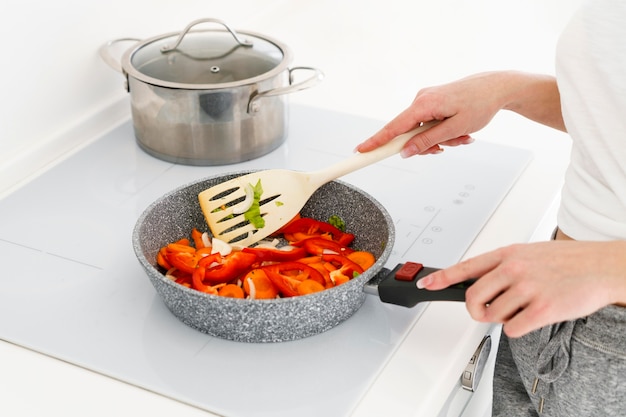lobster tails. Oh, those magnificent crustacean delights! Let me tell you, I'm a bit of a lobster fanatic. That tender, sweet meat, the way it melts in your mouth – pure culinary bliss. But, as any seasoned cook knows, nailing the cooking time is crucial. Undercook it, and you're left with rubbery, chewy disappointment. Overcook it, and you'll be chewing on a dry, tough piece of something that resembles lobster in name only.
So, I’ve compiled this comprehensive guide to lobster tail cooking time, infused with my personal experiences and tips. We’ll cover everything from choosing the perfect lobster tail to mastering different cooking techniques and ensuring you achieve that perfect, succulent result every time. Grab a glass of chilled white wine, settle in, and let's embark on this delicious journey together.
(Part 1) Choosing the Right Lobster Tail: The Foundation of a Delicious Feast

Size Matters: A Lobster Tail’s Proportions
First and foremost, let's talk size. When it comes to lobster tails, bigger is better. They not only offer a more impressive visual appeal but also boast a higher ratio of delicious, juicy meat to shell. Aim for a tail weighing at least 6-8 ounces, ideally around 10 ounces. Trust me, you won't regret going for a larger tail.
Freshness: The Key to Unlocking True Flavor
Next, it's all about freshness. Give that lobster tail a good look. A shiny, vibrant shell is a telltale sign of freshness. It should also feel firm to the touch. Avoid tails with dull, dry shells or those that feel soft or mushy. If you're buying frozen, make sure the packaging is intact and there are no signs of thawing and refreezing.
Frozen vs. Fresh: The Great Lobster Debate
Now, the age-old question: frozen or fresh? Both have their merits. fresh lobster tails, undeniably, offer the most exquisite flavor, but they can be expensive and harder to find. frozen lobster tails, on the other hand, are readily available, have a longer shelf life, and offer convenience – you can thaw them whenever you're ready to cook.
My Personal Preference: A Frozen Lobster Tale
Honestly, I'm a fan of frozen lobster tails. I've found that, especially if you choose a good quality brand, frozen tails can be just as delicious as fresh. They’re incredibly convenient, especially for those spontaneous lobster cravings.
(Part 2) Preparing the Lobster Tail: A Step-by-Step Guide

Thawing: Patience is a Virtue in the Kitchen
If you're working with a frozen lobster tail, thawing is crucial. The best method is to let it thaw overnight in the refrigerator. This slow, gradual process ensures even thawing, preserving the texture and flavour.
Don’t Rush the Thaw: Avoid a Watery Lobster Tragedy
I’ve made the mistake of trying to speed up the process in the past – thawing it in cold water or even using the microwave. Big mistake! The meat ended up watery and the flavour simply wasn't as good. So, be patient, my friends. Let that tail thaw slowly and naturally.
Removing the Shell: A Gentle Extraction
Once your lobster tail is thawed, you'll need to remove the shell. Find the seam running along the underside of the tail. Carefully use a sharp knife or kitchen shears to cut along this seam, separating the top and bottom sections.
Revealing the Prize: The Lobster Meat
Now, you’ll see the beautiful lobster meat nestled inside the shell. Gently pull out the meat, taking care not to tear it. If you're not serving it whole, you can cut the tail into smaller portions for easier eating.
(Part 3) Cooking Methods: A Variety of Options for Lobster Tail Lovers

Grilling: Embracing the Smoky Flavors
Grilling is a fantastic way to cook lobster tails, especially when you're having a barbecue or outdoor gathering. The grill imparts that irresistible smoky flavor and creates a beautiful char. Just preheat your grill to medium-high heat and cook the tails for about 5-7 minutes per side.
Roasting: An Easy and Elegant Method
Roasting is another excellent choice, perfect for cooking multiple lobster tails at once. Preheat your oven to 400°F (200°C), place the tails on a baking sheet, and roast for about 10-12 minutes. You can add a little butter and herbs to the baking sheet for extra flavour.
Boiling: The Classic Approach to Lobster Tail Cooking
Boiling is a classic method that's surprisingly simple. Fill a large pot with salted water, bring it to a boil, and gently lower the tails into the water. Cook for approximately 5-7 minutes, depending on the size of the tails.
Steaming: A Gentle Method for Preserving Flavor
Steaming is a delicate way to cook lobster tails, preserving their delicate flavor. Place the tails in a steamer basket over boiling water and steam for about 8-10 minutes. The steam cooks the meat evenly, resulting in tender, juicy lobster.
Pan-frying: Achieving a Crispy, Delicious Crust
Pan-frying is a great way to give your lobster tails a crispy crust. Heat some butter or oil in a skillet over medium-high heat and cook the tails for about 3-4 minutes per side.
(Part 4) Determining Doneness: The Key to Perfect Lobster
Visual Clues: The Signs of a Well-Cooked Lobster
One of the easiest ways to tell if your lobster tail is cooked is to observe the meat. As the meat cooks, it will change from translucent to opaque, and the shell will turn a vibrant red colour.
The Flesh Test: A Firm Touch for a Firm Lobster
You can also test the flesh with a fork. A properly cooked lobster tail will have firm flesh that springs back when you press on it.
The Shell Test: A Sign of Lobster Readiness
Another handy tip is to check the shell. If the shell easily pulls away from the meat, it's a sign that your lobster is cooked.
The Art of Avoiding Overcooking: A Lobster’s Golden Rule
Remember, lobster cooks very quickly, so overcooking is a real possibility. Once you see the meat turning opaque and the shell is a brilliant red, it's best to err on the side of caution and remove the lobster tails from the heat.
(Part 5) Lobster Tail Cooking Time: A Quick Reference Guide
Here's a handy table to provide a general guideline for cooking times for different methods:
| Cooking Method | Size (oz) | Cooking Time |
|---|---|---|
| Grilling | 6-8 | 5-7 minutes per side |
| Roasting | 6-8 | 10-12 minutes |
| Boiling | 6-8 | 5-7 minutes |
| Steaming | 6-8 | 8-10 minutes |
| Pan-frying | 6-8 | 3-4 minutes per side |
Remember: Guidelines are Just a Starting Point
These are just general guidelines. Always check the doneness using the methods mentioned earlier. It's better to slightly undercook a lobster tail than to overcook it.
(Part 6) Serving and Enjoying Your Lobster Tail: The Culinary Finale
Butter: A Culinary Love Affair
I'm a firm believer that a good pat of melted butter is essential for any lobster tail. You can also enhance the experience with a squeeze of fresh lemon juice, a sprinkle of chopped parsley, or a drizzle of garlic butter.
side dishes: The Perfect Accompaniment
A simple green salad is a classic pairing for lobster. But you can get creative with other sides, such as creamy risotto, roasted vegetables, or even crusty bread for soaking up the delicious buttery sauce.
Drinks: A Toast to the Lobster Experience
For the ultimate lobster experience, pair it with a crisp, dry white wine, like Sauvignon Blanc or Pinot Grigio. If you're feeling adventurous, a light red wine, like Pinot Noir, can also be a delightful complement.
Savoring the Moment: A Culinary Celebration
Now, this is the best part! Sit back, relax, and savor that beautiful, sweet lobster meat. You've worked hard to perfect it, so take your time and enjoy the delicious reward!
(Part 7) Lobster Tail cooking tips and Tricks: Elevating Your Lobster Game
Patience: The Secret Ingredient to Lobster Success
As I mentioned before, lobster is delicate, and patience is key. It's tempting to rush the cooking process, but resist the urge! Overcooked lobster will be dry and tough, so err on the side of undercooking.
Flavor Boost: Adding Layers of Taste
Before cooking, consider adding a touch of garlic, herbs, or spices to your lobster tail for extra flavor. I personally love to rub some garlic and lemon zest on the inside of the shell before grilling.
The Shell Trick: A Simple Technique for Moisture
If you're grilling or roasting lobster tails, leave the shell on for the first few minutes of cooking. This helps to steam the meat, keeping it moist and succulent.
Leftovers: A Delicious Second Act
If you have any leftover lobster tail, it's delicious cold. It's great in salads or sandwiches. You can also freeze it for later use.
(Part 8) FAQs: Your Lobster Tail Questions Answered
1. What does lobster taste like?
It's a unique and delectable flavor – sweet, delicate, with a hint of brininess. It's truly something special!
2. Is lobster healthy?
Lobster is a good source of protein, omega-3 fatty acids, and vitamin B12. However, it's also high in cholesterol, so enjoy it in moderation.
3. Is lobster expensive?
Lobster tails can be expensive, but you can find good deals if you shop around. Look for sales and consider buying in bulk if you plan on cooking lobster often.
4. Can I cook lobster tail in the microwave?
I wouldn't recommend it. Microwaving lobster tails can often result in unevenly cooked, rubbery meat.
5. How do I store leftover lobster tail?
Store leftover lobster tail in the refrigerator for up to 3 days. You can also freeze it for later use.
Conclusion: Mastering the Art of Lobster Tail Cooking
There you have it! From choosing the perfect lobster tail to understanding the nuances of cooking techniques and enjoying the final delicious result, you are now equipped to become a lobster tail master. Remember, it's all about taking your time, selecting the best quality lobster tails you can find, and using the right cooking methods. Happy cooking, and enjoy the delicious journey!
Everyone is watching

Prime Rib Roast Cooking Time Chart: Per Pound Guide
Cooking TipsPrime rib roast. Just the name conjures images of lavish dinners, crackling fires, and hearty laughter. It’s ...

How Long to Bake Potatoes in the Oven (Perfect Every Time)
Cooking TipsBaked potatoes are a staple in my kitchen. They're incredibly versatile, delicious, and surprisingly easy to m...

Perfect Rice Every Time: The Ultimate Guide to Cooking Rice
Cooking TipsAs a self-proclaimed foodie, I've always been a bit obsessed with rice. It's the foundation of countless cuisi...

The Ultimate Guide to Cooking Asparagus: Tips, Techniques, and Recipes
Cooking TipsAsparagus. The mere mention of this spring delicacy conjures up images of vibrant green spears, crisp and burs...

Ultimate Guide to Cooking the Perfect Thanksgiving Turkey
Cooking TipsThanksgiving. Just the word conjures up images of overflowing tables laden with delicious food, the scent of r...
